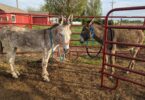Patience is a Virtue
Do you dream of having a horse that stands still regardless of what’s going on around him? Some horses are indeed naturally calmer than others. But the ability to stand still is a skill that shouldn’t be reserved for the show ring—it’s also a matter of safety.
If your horse dances a jig every time you try to get on, today’s article is just for you! We’ll cover essential training tips for teaching your horse to stand still when grooming, mounting, and other situations you may find yourself in. Keep reading for troubleshooting and tips related to teaching this essential skill.
Horse Training 101
Successful training is built on a foundation of trust and respect between horse and rider. Good communication is vital!
Training the Basics
Horses learn best through positive reinforcement. This means actively looking for behaviors you want to see from your horse and providing rewards.
Depending on the situation, rewards may include a treat, a pat on the withers, or a release of rein pressure.
Refrain from punishing your horse for making an honest mistake. Your horse will make mistakes as he learns, and that’s ok. It would be best if you instead tried always to find ways to help him win and reward him generously when he gets the correct answer.
Find a professional trainer if your horse displays aggressive behavior or you feel nervous around him.
Similar to humans, horses often have their own emotional baggage or bad habits they’ve accumulated over time. A trainer can help you improve your relationship with your horse safely.
Teaching Ground Manners
Training your horse to respect your space on the ground is vital regardless of your riding discipline.
- Ideally, your horse should do the following:
- Keep his head near your elbow while being led
- Follow the pace you set while being led
- Quickly move away from you when asked
- Stand tied without pawing or fidgeting
- Respect your personal space

Photo cred: Canva
If your horse struggles with any of the above, teaching him to follow fundamental cues is one of the best places to start. Start by teaching him to put his head down when pressure is applied to the lead rope—this is one of the most basic cues your horse should respond to.
Start by applying downward pressure to the lead rope. Observe for even the slightest downward movement of his head and completely release pressure on the lead rope the second your horse gives.
Continue practicing until your horse will reliably drop his head with very minimal cueing.
If your horse crowds you while leading, teach him to move his shoulder away from you when asked. And if your horse lags behind while leading, you can use a lunge whip to gently encourage him to keep pace.
Consistency, Repetition, and Patience
Stay consistent with your training, and you will see your efforts start to pay off in big ways.
Continue building on the simple exercises described above by following through during every interaction you have with your horse.
With repetition and patience, you should gradually begin to see a difference in your horse’s ground manners. Stay positive and remember to look for those behaviors you can reward rather than punishing mistakes of effort.
If you run into challenges, always consult an expert trainer for help.
To Stand Quietly
The ultimate training goal is a horse that stands quietly regardless of the circumstances. It could be while you’re on his back in the middle of the show ring. Or it might be a grooming session at the barn.
There are any number of situations in and out of the saddle in which your horse needs to stand quietly.
How do you stop a horse from fidgeting?
To stop the fidget, you sometimes need to figure out why it’s happening in the first place.
There are several reasons why your horse may be fidgeting. If your horse is young, he may still need to develop the attention or patience to stand quietly. Or, if your horse hasn’t had enough exercise, his need to expend energy can come out as fidgeting.
When a horse is nervous or uncomfortable, it will be difficult for him to stand still without fidgeting.
Spend some time considering the circumstances under which the fidgeting occurs. Does it consistently happen when trying to groom him? Or does it happen when trying to saddle him? Maybe your horse only fidgets at a horse show, when waiting at a cone. There are a huge range of circumstances and stimuli to consider!
It’s always best to take care of physical issues first. If you believe the fidgeting could be related to pain, address it first with your veterinarian.
If the fidgeting is related to insufficient exercise, ensure your horse gets the wiggles out before asking him to stand still. Once you’ve eliminated all other causes, you can then start to work on training your horse to stand still.
Standing for Grooming
The basic principle behind getting your horse to stand still is to create a situation where the horse sees rest as a reward. Although horses will romp and play out in the pasture, the movement is on their terms.
When you ask a horse to move its feet, the activity turns into work.
How do you train a horse to stand still while grooming?
Although you will ultimately want to be able to tie your horse while grooming, sometimes it’s easiest to start training this skill in a round pen.
Outfit your horse in a halter and lead rope or lunge line. Grab your grooming gear and a lunge whip and head to the fenced arena or round pen.
Start grooming. The instant your horse starts fidgeting, ask him to move his feet. It can be forward, backward, to the side, or in a circle around you. The key is to make moving a very unappealing option.
After a few minutes, allow him to stop and resume your grooming. If he starts fidgeting again, ask him to move his feet again. If he stands still, great!
Repeat this exercise until your horse understands that standing still is definitely the easiest option. At this point, you should be able to try tying him while grooming. Follow the same procedure of asking him to move his feet if he fidgets while tied.
Standing for Mounting
Training your horse to stand for grooming will also help when it comes time to ride. As with grooming, it’s best to ensure your horse isn’t experiencing any pain that might be causing him to fidget.
What do you do with a horse that won’t stand still at the mounting block?
Once discomfort has been ruled out, proceed similarly with teaching him to stand at the mounting block. Having someone with you for the first several training sessions can be helpful.
Have your helper position your horse squarely by the mounting block. If your horse fidgets while you’re attempting to mount, have the helper cue your horse to move his feet as before. After several minutes, have your helper position your horse by the mounting block again.

Photo cred: Canva
Continue cueing your horse to move if he fidgets while you get on. Once you mount, avoid accidentally cueing him forward by bumping his sides and have him stand for several seconds before giving a definite cue to walk on.
Remember that the point of the exercise is to make standing still the best option for your horse. Asking your horse to move his feet should never be a punishment. This exercise tells your horse that he can move if he wants, but it will be on your terms rather than his.
Consult a professional horse trainer if your horse displays aggressive behavior or doesn’t respond favorably to these training suggestions.

Photo cred: Canva
Troubleshooting
Any horse owner will tell you that every horse is an individual. They each have their own personality, attitude, and experiences which can sometimes result in unique training challenges.
Why won’t my horse stand still?
Whenever you encounter training challenges, always consider discomfort first. Are there any apparent causes of pain that you could eliminate? If there aren’t obvious signs of pain, it may still be worth a call to the veterinarian.
If your horse is energetic, has he had enough exercise to get his energy out? Some horses naturally have more energy than others.
It’s not fair to ask your horse to stand for periods if he’s been stalled for hours or hasn’t had enough physical or mental stimulation to use that energy.
Another question to ask yourself is whether the request you’re making of your horse is reasonable, given his age, experience, and level of training. Start slowly by setting your horse up so the “right answer” is easy.
Make your training sessions short and as stress-free for your horse as possible. And in some cases, training sessions with an experienced horse who has mastered standing in place may be helpful.
How do you stop a horse from moving?
Through repetition and consistency, your horse will eventually learn that the easier option is to stop moving. Your horse will learn that it suddenly becomes a lot more work for him if he decides to move!
Beyond teaching a horse to stand still, it’s also important to consistently work on the “whoa” cue both from the ground and saddle.
Desensitizing your horse to sights and sounds can also help him be more confident and less fidgety. Being kind, patient, and consistent with your horse will show him that you are a leader he can trust and rely on when things go awry.
Frequently Asked Questions
Q: How do you teach a horse not to pull back when tied?
Horses that pull back when tied generally have either never been taught to yield to pressure or have had a traumatic event while tied. Either way, horses that display this behavior are dangerous to themselves and anyone around them.
Because the horse’s response to tying is fear-based, re-training the horse’s reaction to being tied is challenging. Instead, you can work on ground-tying exercises and teach your horse to yield to pressure in non-threatening situations. Reward generously and make the experience very positive for your horse.
This behavior is dangerous, and you should consult a professional horse trainer for help. And in the short term, do not tie your horse.
Q: How do you teach a driving horse to stand still?
Teaching a horse to stand still while driving is similar to introducing him to stand still in other contexts. Start by asking for short periods of standing, then gradually increase the length of time you expect your horse to stand in one spot.
You can also reinforce the “whoa” cue from the ground and the cart. And remember to reward your horse for standing still, ideally with a treat or by verbally praising him.
Sometimes peer pressure can be a very effective teacher! This is one situation where it may be helpful to pair your horse with a solidly trained horse. The younger horse will often look to the more experienced horse for cues about responding in various situations.
Finally, practice driving and stopping in different environments. This will help your horse get used to standing in various places and conditions.
Q: How do you teach a horse to stand square?
The goal of teaching a horse to stand square is to encourage him to balance himself evenly with all four legs approximately equal distance apart.
This will require patience and consistent practice because horses don’t naturally stand this way. Establish a cueing system with your horse on moving specific parts of his body.
Although you can pick up his feet and apply pressure to his shoulders at home, you will be docked points if you plan to do halter or showmanship classes.
Touch your horse only sparingly to help him understand what part of his body you’re cueing him to move. Keep your practice sessions very short and reward generously!
With patience and practice, your horse will soon be standing square and steady.
Q: How do you teach a pushy horse ground manners?
Horses can be persistent and pushy when they want something. To teach a horse good ground manners, you must establish yourself as the leader, meaning he must stay out of your personal space.
Start by teaching your horse to yield to pressure in non-threatening situations, such as asking him to move away from you or step aside.
Reward generously with treats and verbal praise when he complies with your request.
Stay consistent with your training and consult an expert trainer if your horse displays pushy or aggressive behavior.

Photo cred: Canva
Parting Thoughts
Teaching your horse to stand still is essential in creating a solid bond and a successful riding experience. By consistently rewarding good behavior with treats and verbal praise, you can help your horse understand what behavior is expected of him.
Remember that all horses are different, so patience and perseverance are essential when teaching them new things. If you’re ever faced with a training roadblock, consulting an experienced horse trainer can help.
Good luck and happy training!
P.S. Enjoy this article? Trot on over to:
- Pressure and Release Training for the Horse that Won’t Listen
- 6 Easy Clicker Training Exercises for Horses (With Pictures)
- The (Mostly) Good Nature of Horse Nudges
- Claim Your Space: How To Scare a Horse Away (Kindly)
- Understanding (And Dealing With) The Spooky Horse
- Mission Possible: Teaching Your Horse to Trail Ride Alone
Sources
- How to teach a horse to stand still? Helpful tips from the experts (horseandhound.co.uk)
- Teaching a Horse to Stand Still – AQHA
- Stop Horse’s Fidgety Behavior During Grooming | Downunder (downunderhorsemanship.com)
- Horses That Pull Back When Tied (equinebehaviorist.ca)
- Teach Your Horse to Square up for Showmanship Classes (horseillustrated.com)







